
Shiva, also known as Mahadeva or Hara, is one of the principal deities of Hinduism. He is the Supreme Being in Shaivism, one of the major traditions within Hinduism.

Parvati, also known as Uma and Gauri, is the Hindu goddess of power, energy, nourishment, harmony, love, beauty, devotion, and motherhood. In her complete form, she is a physical representation of Mahadevi also known as Adi Shakti, the primordial power behind the creation of the universe, the creator and destroyer. She is one of the central deities of the goddess-oriented sect called Shaktism, and the supreme goddess in Shaivism. Along with Lakshmi and Sarasvati, she forms the Tridevi.
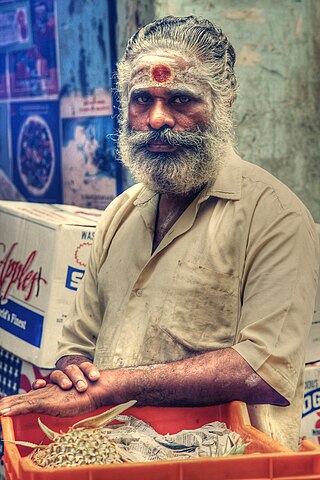
In Hinduism, vibhuti, also called bhasma or tirunīru, is sacred ash made of burnt cow dung as per Agamic texts. Devotees of Shiva apply vibhuti traditionally as three horizontal lines across the forehead and other parts of the body.

The Shri Trimbakeshwar Shiva Temple is an ancient Hindu temple in the town of Trimbak, in the Trimbakeshwar tehsil in the Nashik District of Maharashtra, India, 28 km from the city of Nashik and 40 km from Nashik road. It is dedicated to the Hindu god Shiva and is one of the twelve jyotirlingas where the Hindu genealogy registers at Trimbakeshwar, Maharashtra are kept. The origin of the sacred Godavari River is near Trimbak.
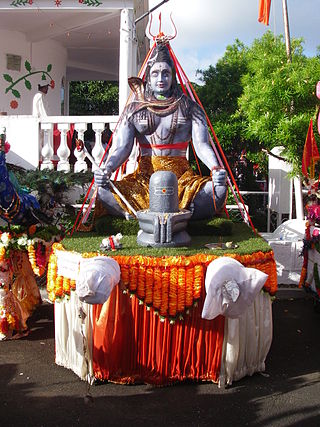
Maha Shivaratri is a Hindu festival celebrated annually in honour of the deity Shiva, between February and March. According to the Hindu calendar, the festival is observed on the fourteenth day of the first half of the lunar month of Phalguna. The festival commemorates the wedding of Shiva and Parvati, and the occasion that Shiva performs his divine dance, called the Tandava.

Kashi Vishwanath Temple is a Hindu temple dedicated to Shiva. It is located in Vishwanath Gali, in Varanasi, Uttar Pradesh, India. The temple is a Hindu pilgrimage site and is one of the twelve Jyotirlinga shrines. The presiding deity is known by the names Vishwanath and Vishweshwara, literally meaning Lord of the Universe.

Sati, also known as Dakshayani, is the Hindu goddess of marital felicity and longevity, and is worshipped as an aspect of the mother goddess Shakti. Sati was the first wife of Shiva, the other being Parvati, who was Sati's reincarnation after her death.

A shaligram, or shaligrama shila, is a fossilized stone or ammonite collected from the riverbed or banks of the Kali Gandaki, a tributary of the Gandaki River in Nepal. It is also considered a form of Vishnu within Hinduism.The Kali Gandaki river flows through sacred places such as Muktinath and Damodar Kunda, enhancing the spiritual significance of these shaligrams.

Arundhati is married to the sage Vasishtha, one of the seven sages (Saptarshi) of Hinduism.

The Jangam or Jangamaru are a Shaiva order of religious monks. They are the priests (Gurus) of the Hindu Shaiva sect, Gurus of Veerashaiva sect and are disciples of Shiva as mentioned in Basava Puranas. The meaning of word Jangam is 'moving linga'. Jangama is one who is endowed with true spirit of Agamic knowledge, and has sacrificed his life for giving Samskara (good) character building practices in all sections of the Hindu society.
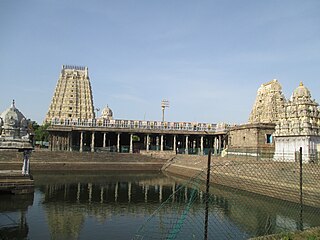
Ekambareswarar Temple is a Hindu temple dedicated to the god Shiva, located in the town of Kanchipuram in Tamil Nadu, India. It is significant to the Hindu sect of Saivism as one of the temples associated with the five elements, the Pancha Bhoota Stalas, and specifically the element of earth, or Prithvi. Shiva is worshiped as Ekambareswarar or Ekambaranathar or Rajlingeswaram, and is represented by the lingam as Prithvi lingam. His consort Parvati is depicted as Elavarkuzhali.

Veeragase/Guggla is a dance form prevalent in the state of Karnataka, India. It is a vigorous dance based on Hindu mythology and involves very intense energy-sapping dance movements performed by Jangama. Veeragase is one of the dances demonstrated in the Dasara procession held in Mysore. This dance is performed during festivals and mainly in the Hindu months of Shravana and Karthika. It is performed at all important functions of Veerashaiva Lingayat household the veeragase artist's are called as puravanta in village side.

Pradosha or Pradosham is a bimonthly occasion on the thirteenth day (Trayodashi) of every fortnight in the Hindu calendar. It is closely connected with the worship of the Hindu god Shiva. The auspicious three-hour period 1.5 hours before and after sunset is considered as the most suited and optimal time for worship of Shiva on this day. The fasting vow performed during the period is called "Pradosha vrata". A devotee should wear rudraksha, Vibhuti and worship Shiva by abhisheka, sandal paste, bael leaves, fragrance, deepa and naivedya.
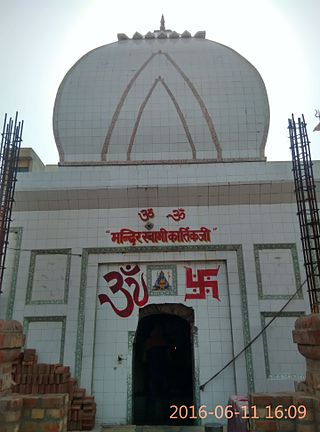
Kartikeya Temple in Pehowa township of the North Indian state of Haryana is one of the oldest Karthikeya temple in North India. Kartikeya is a popular Hindu deity in India and is worshiped across the length and breadth of the country. Like most Hindu deities, He is known by many other names, including Murugan, Senthil, Saravaṇa, Arumugam or Shanmukha, Kumāra, Guha, Skanda. The Kushanas, who governed from what is today Peshawar, and the Yaudheyas, a republican clan in the Punjab, stuck coins bearing the image of Skanda. The deity was venerated also by the Ikshvakus, an Andhra dynasty, and the Guptas.

Thirukutralam represents one of the five Pancha Sabhas of Nataraja - Chitra Sabhai. The five dance halls of Shiva are Chidambaram, Madurai, Thiruvalangadu, Tirunelveli and Kutralam. Kutralam is also known as Trikootaachalam.
Bahaghara is a wedding ceremony performed by Odia Hindu people in the Indian state of Odisha. There are subtle differences in the rites observed by different castes. In Odia marriage rituals, the mother of the bridegroom does not take part in the ceremony. The Utkala Brahmins have their weddings only in the daytime, preferably at midday or in the morning, while the other caste weddings are done during the evening or night. There is the custom of sending betel nuts to family friends for inviting them to the marriage. The first invitation is sent to the family deity as a respect to the lord. Marriages in Odisha are mostly fixed and arranged by the parents. Marriages for serving or capturing is not common.

The Mangadu Kamakshi Amman Temple is a famous pilgrim destination Hindu temple dedicated to goddess Parvathi, located in Mangadu, a suburb of Chennai, India. The term Mangadu means "Mango Forests or Mango Groves" and as the term implies this must have been a thickly wooded Mango groove in times of yore.

Sonna Puriyathu is a 2013 Indian Tamil-language comedy film directed by debutant Krishnan Jayaraj, a former associate of C. S. Amudhan It stars Shiva and Vasundhara. The film was released on 26 July 2013. It had a good opening and finally declared as an above average hit in the boxoffice. The film's title is based on a song from Velayudham (2011).

Chengannur Mahadeva Temple is a prominent Hindu temple, dedicated to Shiva and located in the town of Chengannur in the South Indian state of Kerala. The temple is one of the major Shiva temples in Kerala, along with the Ettumanoor Mahadevar Temple, Kaduthruthy Mahadeva Temple, Vaikom Temple, Ernakulam Shiva Temple and Vadakkunnathan Temple. There are shrines for Ganesha, Dakshinamurti, Subrahmanya, Shasta, Krishna, Nilagriva, Sthalisha, Hanuman, Ganga, and serpent deities inside and outside the temple complex.
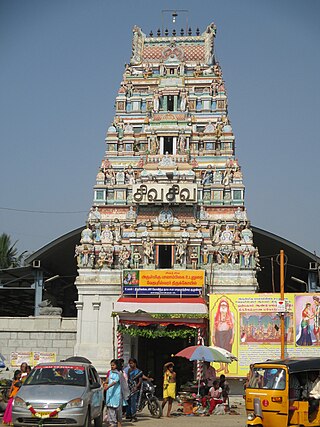
Vedapureeswarar Temple is a Hindu temple dedicated to the deity Shiva, located in Thiruverkadu, a Municipality in Tiruvallur district in the South Indian state of Tamil Nadu. Shiva is worshipped as Vedapureeswarar, and is represented by the lingam. His consort Parvati is depicted as Balambigai. The presiding deity is revered in the 7th century Tamil Saiva canonical work, the Tevaram, written by Tamil saint poets known as the Nayanars and classified as Paadal Petra Sthalam.

















